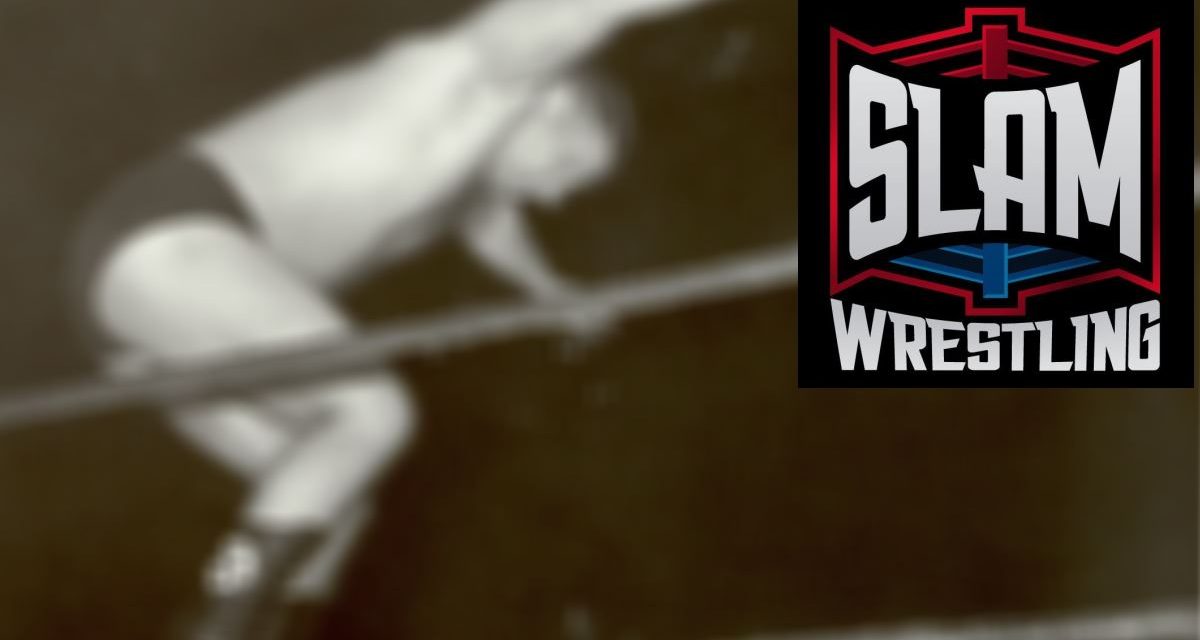Among wrestlers, Gerald “Jerry” Brisco is something of a renaissance man: he has truly done it all.
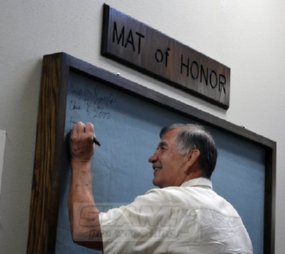
Gerald Brisco signs the new Mat of Honor at the George Tragos/Lou Thesz Professional Wrestling Hall of Fame at the National Wrestling Hall of Fame Dan Gable Museum in Waterloo, Iowa on Saturday, July 19, 2014. Photo by Joyce Paustian.
From amateur success to tag-team glory with his brother Jack to three decades as a backstage agent and talent scout, Brisco has lived and breathed wrestling for practically his whole life.
So it should be no surprise to anyone who has followed his career that Brisco will receive the Lou Thesz Lifetime Achievement Award at the Cauliflower Alley Reunion in Las Vegas, April 12-15. SLAM! Wrestling recently caught up with Brisco for an in-depth chat about his life, career, and perspectives on the future of wrestling.
In part one of our interview, Brisco discusses amateur wrestling, tag team chemistry, and his brother Jack.
Stay tuned to SLAM! Wrestling for part two, in which Brisco delves into innovators, WrestleMania, and giving back to the business.
SLAM! Wrestling: First off, congratulations on receiving the Lou Thesz Award at the upcoming Cauliflower Alley Club 50th Reunion.
Jerry Brisco: Yeah, it just means so much to me to get anything with Lou’s name attached to it. The Lifetime Achievement Award, it means two things: one, you did something right and two, you’re gettin’ old (laughs). I’m really honoured by the CAC to be presenting me with the Lifetime Achievement Award, I’m just really proud of it. It’s special to me because I was close with Lou during his last years when he lived in Florida, and got to see him quite a bit and became pretty good friends, really, so that means a lot.
SLAM! Wrestling: What made Lou Thesz so extraordinary?
Jerry Brisco: Lou was just a natural athlete and an outstanding athlete also. He was a perfectionist, and I think when he went in the ring he did everything with 100 per cent effort and skill. Lou just did things that extenuated his talents, and I think that’s what made him special. He was just a special performer in the ring, and a special worker in the ring, and knew what he was doing, and wasn’t in a hurry like a lot of the kids these do nowadays.
He took his time, and told a great story while he was in the ring. One of my favourite matches was him and Buddy Rogers. I’ve watched that match several times, and it’s just a superb match. Buddy was a tremendous worker too. Buddy, Lou, my brother Jack, and Danny Hodge, they just had a way about them.
SLAM! Wrestling: Danny Hodge is one of your heroes, right?
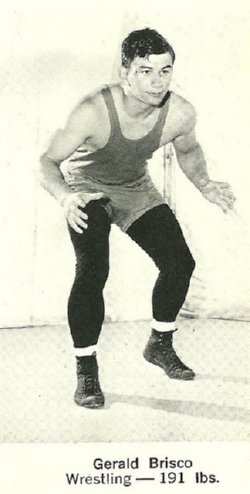
Jerry Brisco: Yeah, he certainly is. I grew up in Oklahoma of course, as everybody knows, and Danny grew up less than 20 miles from where I live. Danny was one of my heroes when I was like pre-teen. One of the reasons I wanted to wrestle was because of Danny Hodge. We lived in northern Oklahoma, and we could barely get the Oklahoma City channel that showed late Saturday night Oklahoma City Wrestling, promoted by Leroy McGuirk, and I used to watch Danny and I’d think that’s what I want to be.
And of course my brother was the same way. I started in amateur wrestling and then just naturally followed into professional wrestling, basically because of Hodge. Hodge was truly one of my heroes and still is today, he’s 83 years old and every time I see him, I feel that real sense of glee. I go to shake his hand and he plays with me and squeezes a little bit. Danny’s a lot of fun and he attends all these reunions so I’m looking forward to seeing him also.
I’m a scout for WWE and I go to all the amateur wrestling tournaments and in Oklahoma. Every time I’d walk into the building my tickets were close to Danny’s seats, and every time I’d walk in I’d see a circle of fans just laughing and going crazy and I’d say to myself, ‘I bet Hodge is over there.’ So I’d kind of work my way over there, and Hodge would be in the middle of this crowd, putting a headlock on somebody, or shaking their hand and bringing them to their knees. And I don’t care how old they were: they still loved Danny and had a ton of respect for Danny. And Danny can still steal the show even at 83.
SLAM! Wrestling: What are some of the major changes you’ve seen in amateur wrestling over the years?
Jerry Brisco: Amateur wrestling has evolved just like everything else. You have to keep your audience [just like] the U.S.A. Wrestling group and the National Wrestling Coaches Association, the NWCA. They are very proactive in making sure that the product on the mat from these college kids grows every year, and they’ve changed the rules.When I was wrestling, there was a lot of leg stalling where you get dropped down on the legs and grab a hold of the ankles and ride ’em. Now you can’t do that: they make them move up. It’s seven minutes of grueling action now where we had nine minutes, but like I said it was more of a stalling… back in my days. It wouldn’t be a good TV product, and now last year the NCAA Tournament had record high numbers on ESPN, for all three days. They showed all three days of the tournament and they set records for viewership.
And I’m really happy, they have very good leadership now, and I think when the Olympic movement came and the IOC said wrestling was no longer part of the Olympics I think it woke everyone up. It told them, we got to do something with our sport to make it more entertaining. So they know they have to get a little bit more entertaining. I’d like to see them open up a little bit more, but it’s just an old sport, and a traditional sport that they hang on to a lot of things. But it’s evolving every year and it’s growing every year, the National Conference sells out now, with over 100,000 people every year and every session is televised.
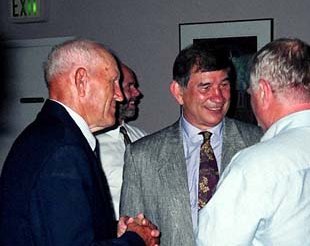
Danny Hodge, left, and Jerry Brisco in July 2005. Photo by Greg Oliver.
And the kids are getting bigger and stronger, better coaching techniques and better work out techniques, just like there is with football, basketball and hockey. Everything evolves and all the training methods get better each decade, and I think they’ve done a great job keeping up with what needs to be done to make it more of a talked about sport.
SLAM! Wrestling: Was your transition from amateur wrestling to professional wrestling a smooth one?
Jerry Brisco: There was a lot of frustration in the early years because I thought I was better than I was. I wasn’t… It takes some time to mature in the ring, it takes some time to find your identity. And I was blessed because [of] having my brother as a tag team partner. And then getting paired up against the Funk brothers, Dory and Terry, for all those years. And even today, that’s still one of the most talked about rivalries in the business.
And the two of them were so smooth and so good. Dory especially was smooth, while Terry was the wild man of the group. And I kind of looked at those two, and I looked at Jack and I, and we both kind of knew what we had to do to keep moving forward.
SLAM! Wrestling: Can you share some insight on the chemistry of the Briscos as a tag team?
Jerry Brisco: Well, even though you’re brothers, it’s a fast-paced business that you’re in, and things are going fast, so you kind of got to be ahead of the game. And of course, I’m a big fan of my brother and I watched most of his matches. And simply from body language, I just knew what he was doing and vice-versa. He knew what I was doing from my body language. And you can read each other a lot more when you’re brothers, I think.
And positioning in our business was so important, and I always knew Jack was going to be in the right spot for me, without me even saying anything. We didn’t have to talk much in our matches. We just kind of reacted to what was happening in the ring. I started wrestling when I was six and Jack started wrestling when he was like 13 or 14, so you gain a lot of experience even though it was amateur wrestling. You just get a lot of the experience of body movement and knowing where you’re going and it’s just kind of studying the physics of the body and the movements and everything. And I really think being brothers put us ahead of a lot of people in the ring because we knew what each other were doing, basically before we did it, because we were reading each other’s body language so well.
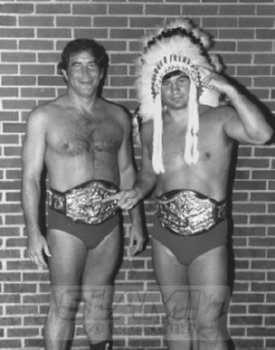
The Briscos with the stolen headdress of Jay Youngblood.
SLAM! Wrestling: What do you think set the Briscos apart from other tag teams?
Jerry Brisco: If you think back to the ’70s, Jack and I were college kids and there weren’t a lot of college kids in the business at that time. We had long hair and got razzed about our hippie hair. We were called hippies all the time, we wore the bell bottom slacks and sweaters, and I think we were different enough. And that set us apart, besides being brothers, and being the amateur wrestlers that we were. And to go out and put on a wrestling demonstration while we’re still working, and still blending our amateur style in with our professional style, and I think that’s what made us the unique team that we turned out to be.
SLAM! Wrestling: Did you enjoy your heel run in the Carolinas in the ’80s?
Jerry Brisco: I sure did, and I think that’s when I really found myself, when we turned full blown heels on Ricky Steamboat and Jay Youngblood. That was one of the best times I ever had in the business because I think my promos got better, and I think my work got better. Working heel taught me a lot. We’d worked heel before, when we’d go to Texas of course, and we worked heels in Florida against Mike Graham and Steve Keirn, but not to the extent where we were full-blown heels like we were in the Carolinas against Steamboat and Youngblood.
So I think I was in my early 30s then, and I think that’s when I really started feeling like, I’m just about where I want to be. You never are really exactly where you want to be, but I think I was as close as I was ever going to get during that heel run in the Carolinas with those two guys.My heel run was my favourite run of all time. And of course the Funks, that went worldwide, we went everywhere wrestling was. They booked the Funks and Briscos — Japan, Australia, Puerto Rico, all over the United States, the big events in places like St. Louis and Houston, were the big events at that time, Greensboro, Atlanta, Charlotte, Miami, Tampa, Kansas City, all over the place. That was probably the biggest run, but the most enjoyable run was the heel run because like I said earlier, it let me come out a little bit more of myself and open up.
SLAM! Wrestling: How did Jack feel about doing heel promos?
Jerry Brisco: Jack hated doing the heel promos. If you remember, he’d let me do most of the talking and he’d say, tell ’em Gerald. (laughs) And then I’d go off on a rant.
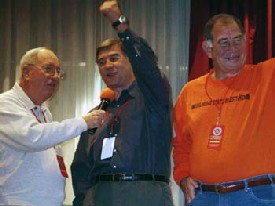
Jerry and Jack Brisco are interviewed by Bob Caudle in 2004. Photo by Steven Johnson.
There’s a promo on YouTube now that somebody sent me the other day that I’d forgotten all about. And you know how Edge and Christian used to do that five-second photo op? Well, Jack and I were doing a promo with Bill Ward, the commentator in Mid-Atlantic Wrestling and so I come out and I said a couple words, something like: “I know you people are tired of what I’ve got to say, you’re tired of listening to me, so I’m going to give everybody out there what you want the most. Jack and I standing here for five seconds smiling pretty for you.”
So we just stood there and didn’t say a word for five seconds, just smiling real arrogantly and then walked off the set. So I said to Edge, “You stole that!” and he said he never saw it. So I joked, that was the original five-second pose (laughs).
SLAM! Wrestling: Before that memorable match you and Jack had at Starrcade ’83 against Steamboat and Youngblood, there’s a great shot of you standing on the corner turnbuckle looking across the ring at your opponents…
Jerry Brisco: Yeah, I get asked about that a lot (laughs). I go to the training camp a lot where the young guys watch a lot of tapes and they ask me, “What were you doing up there?” I was probably up there two minutes and I’m not really a coordinated guy, and Angelo Mosca was in there. He’s a giant of a guy, the great Canadian football player and great professional wrestler that he was. So I’m not the tallest guy and it just came into my mind, ‘You know, I’m going to get up there and I’ve never done that before ever in my life.’ And so I wasn’t sure, and I was a little nervous that I’d get a little shaky, especially when they’d starting climbing into the ring and jumping around and that top turnbuckle gets a little shaky. But I was able to maintain my balance, and it made for a memorable moment from that event.
But I wanted to come across as a little arrogant, and I thought standing up there as the world tag team champion would give me that demeanor, and I think it certainly did because to this day I still get a lot of comments about it. I don’t think anybody has ever has done it since. I enjoyed it and I still get a lot of compliments about it. I just wanted to be different, and it certainly was, and it kind of set the tone because people were calling me all kinds of names just for standing on the top turnbuckle. Fans were yellin’ and cussin’ me out, “Get the hell down from there, you’re an idiot!”
But that match we had against Steamboat and Youngblood at Starrcade, I don’t think it could have gone off any better than it did, working with those two great young athletes. It was like passing a torch to them and I felt very proud of that. One thing my brother and I never had any problem doing was helping out young guys and making their careers better.
SLAM! Wrestling: After Starrcade ’83, you and Jack headed for New York. How did you feel about your run in the WWF after all those years in the NWA?
Jerry Brisco: We’d done big shows before, but one week I remember specifically, I was in Madison Square Garden and I had goosebumps. I had been there before when I was younger, and then we went to Boston Garden where I had never worked before. I remember the fans were so rowdy, and they’d throw stuff at the guys as they were coming out. I can remember standing in the middle of the ring and looking up and seeing Boston Celtics and Boston Bruins, and all those championship banners hanging from the roof. Like being at Madison Square Garden, that gave me goosebumps as well, and it kind of made me nervous too, just knowing the stars who had been in that building and been in the middle of that arena.And having 17,000 people on their feet cheering for you. … Whether it was Boston Garden, or Madison Square Garden [or] Philadelphia [or] Pittsburgh [these were] all the huge places that were different to what I was used to. And it was a different style, but fortunately we were working with Dick Murdoch and Adrian Adonis, who we’d had lots of experience with in other territories. But yeah, it kind of gave me a different feeling like, and I think we felt a bit displaced as well, like, “What am I doing here, I don’t belong here.”
But Murdoch and Adonis were great to work with and they were big rugged heels. And they could go, as big as they were, both big Dicky and Adrian could move like lightweights. So we had a good little routine with them and worked with them I think for close to a year and had great matches with them all over the country. But it was a time where Jack wanted to retire. And he was getting a step slower, which is still quick, but he was getting to that age where he wanted to retire and stay on his farm in Odessa.
SLAM! Wrestling: In preparing your speech for the upcoming CAC Reunion, is there a particular time in your career you find yourself revisiting?
Jerry Brisco: Well, when I first found out I’d be receiving the Lou Thesz Award, of course I’m terrified of public speaking, and I think everybody is if they’re honest with themselves. So I just want to get up there, and yes, a lot of reflection has been done on certain matches and certain opponents. But I found myself thinking more about when I very first began and was opening up cards and the guys I was working with, and the patience and time they took with me. Because I had no formal training.
My formal training was one afternoon, I was on Spring Break from college and I went over to Tulsa where Jack was living, and he got a job in Missouri so I was going to make the move with him during Spring Break. So right before he was leaving for this job, Jack got a phone call from Gorgeous George Jr., who had broken his ankle the night before in a singles match, and so Jack was scheduled to wrestle Buddy Colt and “Dandy” Jack Donovan. So Jack said, “You know, you might have to wrestle tonight. Come here.” So he pushed the table back and he showed me a headlock, he showed me an arm bar, and showed me a takeover and basically that was my pre-match training.
We went to the job in Missouri and I was as nervous as I could be, got there and I used a pair of Jack’s tights, and somebody else had a pair of boots I could wear, ’cause I had no equipment. And back in those days, the cards were so small that you’d have a tag match, along with a little 20-minute warm up match to fill the card up with a few more matches than what was scheduled. So Buddy Colt said, “Let me have him, I’ll take care of him out there.” So they wouldn’t let me throw a punch or kick anybody, so Buddy and I went over a couple things and he said, “Just listen to me out there,” and he said, “You know a headlock, so take me over with a headlock and show me how you’re going to do it.” So I showed him how I grab a headlock, and he said, “Just listen to me out there but don’t throw a punch or kick. If you want to, you can throw a couple forearms.” And he showed me how to throw a forearm, and so we went out and had a 20-minute warm up match, and that was my first match, with just two hours of training. And that was kind of it.
They were a perfect match for us, Buddy Colt and Jack Donovan, were two of the best. Buddy Colt in my opinion is probably one of the most underrated workers in our business. The guy was phenomenal.
SLAM! Wrestling: At the end of his life, was Jack fulfilled with the career he had in wrestling?
Jerry Brisco: Let me tell you something about Jack. Jack was a very unique person. He accomplished everything he wanted to do in the business. He enjoyed his time in the business, and even when you go back to his days in college, he won a National Championship in his junior year. He had one more year left and he wanted to be a pro wrestler so bad that he dropped out of college. He said, “I won a national championship, what more can I do?”
So he went pro to feed his family, and then he won a world championship and kept that as long as he wanted to. Jack gave that up on his own admission. They did not tell him, ‘Jack, it’s time to go.’ They wanted him to stay champion but he made up his own mind: “I’m ready to retire, I’m ready to quit and I’m ready to give up this title and stop traveling.” He was an individual who made his own time schedule and then he stuck by it. Jack’s one of the few guys, if you’ll think about it that when he quit, he quit. He was totally divorced from the business at that time, and he watched it every week on TV, he was a huge fan. So it made him really unique because once he accomplished what he set out to accomplish, it seemed like there were no challenges anymore. And once he achieved his goals, he figured it’s his time to go. He won every title you could imagine, but he set his own time table on quitting and retiring, and once he walked away he was finished with it and he became a fan.
A lot of the old timers, you know, they go, “What the hell’s wrong with the business?” But Jack loved it even when me and [Pat] Patterson were doing all that goofy stuff as Vince McMahon’s stooges. People would ask, what does your brother Jack think? And I’d tell ’em, he thinks it’s crazy! (laughs) And he knew I was having a good time, and that was important for him. He knew I was enjoying the business, he loved it, and he’d just shake his head and he’d say, “You and Pat are crazy!” And he respected Patterson for it, so he was a huge fan of the WWE. He wasn’t bitter like some of the old timers, “What the hell is goin’ on?” they’d say. Some of the guys are making hundreds of thousands of dollars, that’s what’s goin’ on (laughs), we’d tell ’em!
RELATED LINKS
